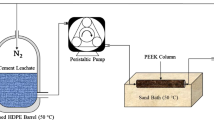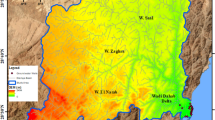Abstract
Computer simulations of carbon dioxide leaching of Aptian–Albian sandstone at the Nagutskoe groundwater field, Caucasian Mineral Waters, are compared with laboratory experimental data obtained using a high-pressure autoclave under parameters close to conditions under which mineral waters are formed at the Nagutskoe and Essentuki fields (temperatures 20–25 and 65–70°C, carbon dioxide pressure up to 4.04 MPa). The solvents were distilled water and naturally occurring groundwaters from the Caucasian Mineral Waters (CMW) area, individual experimental runs lasted for 2 h, the starting material (rock) was crushed to 0.25 mm, and the gas phase was carbon dioxide. In most of the experiments, the solid: liquid phase (R/W) ratio was 1: 5 and was varied from 1: 10 to 1: 100 in other experiments. Our simulation results indicate that multiple-cycle (10 cycles) leaching leads to an increase in mineralization from 1.3 g/L to 4 g/L and transformation of the geochemical type of the waters from the hydrocarbonate calcic–sodic one (leaching cycle 1) to chloride–hydrocarbonate sodic (cycles 5 and later). The mineralization increased mostly because the and Na+ ions are transferred into solution at an insignificant increase in the Cl concentration and a practically unchanging concentrations of the sulfate, calcium, and magnesium ions. With regard for the averaged mineralogical composition of the sandstone (quartz, feldspars, mica, glauconite, magnetite, ilmenite, garnet, rutile, zircon, and tourmaline) used in our thermodynamic simulations, we arrived at the conclusion that the chemical compositions of the waters, including their minor-element compositions, are controlled by (i) the composition of the cement (clay, calcareous, siliceous, limonitic, chloritic, zeolitic, phosphate, sulfate, or mixed) of the rocks, (ii) weight percentages of minerals containing certain elements, and (iii) temperature, at a given composition of the gas phase of the simulated system (silty sandstone–rainwater–CO2 gas phase).
Similar content being viewed by others
References
GIST (State Standard) R 54316-2011. Potable Natural Mineral Waters. General Technical Requirements (Gosstandard Rossii, Moscow, 2011).
D. V. Grichuk, Thermodynamic Models of Submarine Hydrothermal Systems (Nauchnyi Mir, Moscow, 2000) [in Russian].
S. R. Krainov, B. N. Ryzhenko, and V. M. Shvets, Geochemistry of Groundwaters. Theoretical, Applied, and Ecological Aspects. 2nd Ed. (TsentrLitNefteGaz, Moscow, 2012) [in Russian].
A. B. Ostrovsky, G. S. Vartanyan, and S. L. Raikhel, “Gashydrochemical and thermohydrochemial features of deep fluid flow in the Nagut hydroinjection structure, in Proceedings of 2nd All-Union Conference “Natural Gases of the Earth and their Role in the Formation of Earth’s Crust and Mineral Deposits,” (VDNKh SSSR, Moscow, 1982), pp. 22–23.
A. B. Ostrovsky, V. V. Yur’ev, et al., Report on Detailed Explorations at the Nagut Mineral Water Deposits in the Stavropol’ Krai (1974–1980). North Caucasian Territorial Geological Survey (Inozemtsevo, 1980) [in Russian].
E. G. Potapov and S. R. Danikov, “Hydrogeochemical features of the mineral “salt—alkaline” waters of the Essentuki and Nagut deposits, in Actual Problems of Balneology, Rehabilitation Medicine, and Professional Pathology (Pyatigorsk, 2010), pp. 73–74 [in Russian].
V. N. Shvanov, Petrography of Sandy Rocks: Component Composition, Systematics, and Description of Mineral Species (Nedra, Leningrad, 1987).
W. Yang, and P. E. Rosanberg, “The free energy of formation of datolite,” Am. Mineral. 80, 576–584 1995.
Author information
Authors and Affiliations
Corresponding author
Additional information
Original Russian Text © O.A. Limantseva, E.G. Potapov, S.P. Danilov, E.V. Cherkasova, 2016, published in Geokhimiya, 2016, No. 8, pp. 740–747.
Rights and permissions
About this article
Cite this article
Limantseva, O.A., Potapov, E.G., Danilov, S.P. et al. Analysis of accumulation conditions of minor elements in mineral waters: An example of hydrocarbonate sodic waters of the Nagutskoe mineralized groundwater field. Geochem. Int. 54, 712–718 (2016). https://doi.org/10.1134/S001670291608005X
Received:
Accepted:
Published:
Issue Date:
DOI: https://doi.org/10.1134/S001670291608005X




